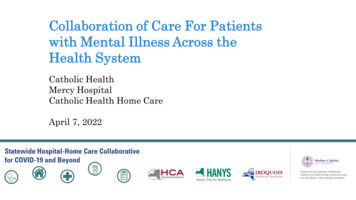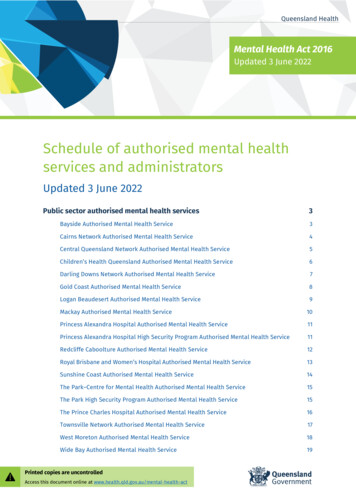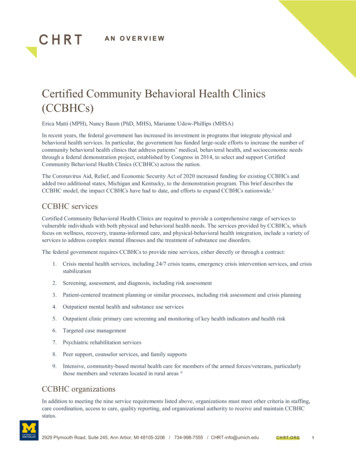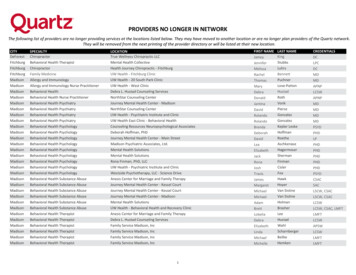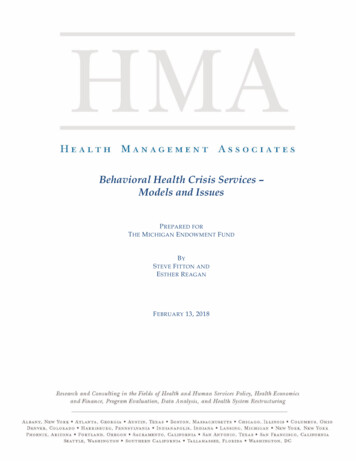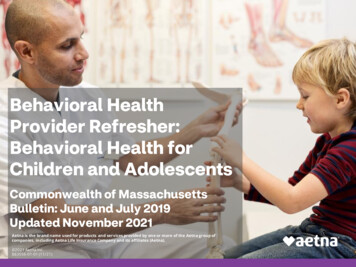
Transcription
Community MentalHealth NeedsAssessmentVentura CountyBehavioral HealthMarch 29, 2019
Table of ContentsAcknowledgments .1Executive Summary.3Background .6Process and Methods . 10Ventura County Profile . 15Key Findings. 23Synthesis of Findings . 48Community Input and Recommendations . 52
AcknowledgmentsVentura County Behavioral Health and Harder Company Community Researchwould like to thank the following individuals for their insight into the mental healthneeds of Ventura County residents, and for their assistance in the design,implementation and interpretation of this community mental health needsassessment.Advisory Group: Anderson, DawnBhavnani, RatanBrooking, GaneDavis, CrystalDenering, LorettaDeutsch, DavidFryhoff, JamesGonzalez, AdrianaHarris, JerryHernandez, MariaHidalgo, RobbieHiggins, ReneeLivingston, MelissaMarrero, LucyMulford, KathyOlivas, DinaPringle, PeteSchipper, JohnVillanueva, HenryWarren, LizWhitney, ScottFor their input on the design of data collection protocols:Patricia Gonzalez, PhDResearch Psychologist, VCBHJonathan Martinez, PhDAssistant Professor, California State University NorthridgeFor carrying out data collection and analysis:Focus Group FacilitatorsAdriana AlmazanMaritza GarciaProvider Survey / Focus Group AnalysisEVALCORP Research & ConsultingKristen Donovan, PhD – President and Principal ConsultantSabrina Perlman, MA – Research AssistantShayla Wilson, MPP – Research Assistant
VCBH Community Mental Health Needs AssessmentIn addition, Harder Company Community Research would like to thank the staff ofVentura County Behavioral Health, for their collaboration on this endeavor:Sevet Johnson, PsyDDirectorJohn Schipper, PhDAdult Division ChiefPete Pringle, LCSWChildren’s Division ChiefKiran Sahota, MASenior Behavioral Health ManagerMental Health Services ActClara Barron, MSProgram Administrator - OperationsGreg BerganProgram Administrator - DataHilary Carson, MSProgram Administrator - InnovationsEsperanza OrtegaCommunity Service CoordinatorElaina Titus-SterlingManagement AssistantMarch 29, 20192
Executive SummaryFrom March 2018 through February 2019, Ventura County Behavioral Health(VCBH) engaged Harder Company Community Research to conduct a CommunityMental Health Needs Assessment (CMHNA) to inform VCBH’s Mental HealthServices Act (MHSA) three-year plan. The CMHNA was designed with the goal ofcreating accessible ways for a wide range of community stakeholders, includingcommunity members and providers, to share their perceptions on mental healthneeds for Ventura County residents, and to identify the most urgent mental healthneeds among unserved and underserved populations in the county.Process and MethodsThroughout the CMHNA, Harder Company, along with VCBH and EVALCORPResearch & Consulting, collected data to inform Ventura County’s mental healthneeds through the following methods:1.A review of existing secondary data on Ventura County’s demographicsand mental health indicators2.A community survey, which reached nearly 5,000 residents, to directlyassess demographic factors, mental health indicators, and feedback onmental health services among community members3.Several community focus groups, reaching over 100 participants, inorder to seek input from underserved or unserved priority populations inthe county4.A provider survey, with input from nearly 700 respondents, to seek inputon the quality of existing mental health services from a wide range ofcounty, private, and non-profit agencies that wok with populations in needof mental health servicesKey FindingsWhile this CMHNA demonstrated wide variation in perceived mental health needsbetween community members and providers, as well as between regions of thecounty and selected priority populations, there was broad agreement on foururgent community mental health needs, namely:1.Lack of access to needed mental health services: 26% of communitysurvey respondents who said they had needed mental health services inthe past year did not received them, while 35% of them said the same of aclose family member. Respondents cited various barriers to access,including lack of health insurance or limited health insurance; inconvenienttiming of services; services requiring too much travel; fear of providermistreatment; and a lack of culturally or linguistically appropriate services.Many priority populations reported high rates of experiences of culturallyinappropriate services, while homeless and Asian/Pacific Islanderindividuals reported a lack of linguistic appropriateness in higherproportions than other groups.2.Depression as a major mental health illness: 52% of community
VCBH Community Mental Health Needs Assessmentsurvey respondents indicated they had been diagnosed with depression bya healthcare provider in the past. About 29% of survey respondents alsoindicated that they had ever thought about or attempted suicide. Diagnosisof depression was fairly uniform across most priority groups, but notablyhigher among homeless (65%) and LGBTQ (62%) individuals, who bothindicated having been diagnosed with depression in higher proportionsthan overall. Suicidal ideation did differ substantially across prioritypopulations, with homeless individuals (56%) and LGBTQ individuals(49%) indicating past suicidal ideation or attempts in higher proportionthan all other groups. Asians/Pacific Islanders, Blacks/African-Americans,and TAY also reported higher-than-overall rates of suicidal ideation orattempts (39-42%).3.The homeless population as a priority in group in particular need ofmental health services: 40% of community survey respondents and60% of provider survey respondents felt that homelessness was one of thetop mental health issues in their community, while about 4% of surveyrespondents indicated they were actually homeless. During VenturaCounty’s most recent point-in-time homeless count, in 2018, there wereabout 1,299 homeless individuals, and about 28% of them had mentalhealth problems, while 26% were substance users. The community surveyfound that homeless individuals reported worse mental health outcomesthan every other priority population across several key factors, including:(1) self-rated mental health status, (2) substance use, (3) suicidal ideationor attempts, and receiving mental health services that were either (4)culturally or (5) linguistically inappropriate. Homelessness is also unevenlydistributed across Ventura County. The 2018 point-in-time homeless countshowed that two thirds of homeless individuals were living in the cities ofOxnard and Ventura, the county’s largest urban centers.4.Substance abuse as a major co-morbidity impacting mental healthstatus: While about 15% of survey respondents indicated they had used adrug other than alcohol or tobacco in the past 12, certain prioritypopulations reported use in substantially higher proportions. For example,41% of homeless respondents to the community survey indicated recentsubstance use, compared to 29% for LGBTQ respondents, 28% for TAYrespondents, and 25% for Asian/Pacific Islander respondents.RecommendationsThis CMHNA sought community input on the findings in this report in order todevelop recommendations about potential services or systems that could helpaddress the top four mental health needs identified through the community andprovider surveys. Key recommendations are briefly outlined below, by topic area:Access to Mental Health Services1.Creation of a mental health navigation service that would serve as a “onestop shop” for education, messaging, and stigma reduction aboutbehavioral health issues, available mental health services and affordability2.Coordination among county-wide service providers to ensure that allclients were triaged to appropriate and timely services regardless of theirentry point to services, similar to what is referred to as a “no wrong door”policy3.Delivering additional education to mental health providers (includingMarch 29, 20194
VCBH Community Mental Health Needs Assessmentcounty agency and non-profit staff) and law enforcement on cultural andlinguistic competencyDepression1.Developing programs for education and outreach on depression in K-12schools in Ventura County2.Focused depression services for low income and homeless individuals, aswell as older adults, and LGBTQ individuals, since these populations maysuffer disproportionally from depression or other mental health conditionsHomelessness1.Conduct further research to better understand homeless subpopulations(chronically homeless, transitionally homeless, dually diagnosed) and theirmental health needs, as well as their geographic distribution across thecounty2.Early intervention services for transitionally homeless individuals, providingneeded supports for individuals at risk for chronic homelessness3.An triage system to allow law enforcement agencies to link homelessindividuals to appropriate mental health providers when mental healthcareis a more suitable responderSubstance Use1.Conduct further research to better understand substance usesubpopulations (by type of substance: e.g. cannabis, opioids, etc.) andtheir mental health needs2.Focused substance use services for low income and homeless individualsAdditionally, Harder Company recommends continuation of communityengagement in assessing mental health needs through periodic, long-termcommunity and provider surveys and focus groups.March 29, 20195
BackgroundPurpose of Mental Health Services ActThe Mental Health Services Act (MHSA), formerly known as California Proposition63, passed in November 2004 with the aim of providing increased funding,personnel and other resources to support county mental health programs spanningthe continuum of prevention, early intervention and service needs.1 MHSA’s visionstatement and guiding principles stress improvement of California’s mental healthsystems through cultural competency, improved access, service efficacy, and thereduction of stigma against those with mental illness.2 The letter of the MHSA itselfoutlines the act’s five key intents as follows:31.2.3.4.5.To define serious mental illness among children, adults and seniors as acondition deserving priority attention, including prevention and earlyintervention services and medical and supportive care.To reduce the long-term adverse impact on individuals, families and stateand local budgets resulting from untreated serious mental illness.To expand the kinds of successful, innovative service programs forchildren, adults and seniors begun in California, including culturally andlinguistically competent approaches for underserved populations. Theseprograms have already demonstrated their effectiveness in providingoutreach and integrated services, including medically necessary psychiatricservices, and other services, to individuals most severely affected by or atrisk of serious mental illness.To provide state and local funds to adequately meet the needs of allchildren and adults who can be identified and enrolled in programs underthis measure. State funds shall be available to provide services that arenot already covered by federally sponsored programs or by individuals’ orfamilies’ insurance programs.To ensure that all funds are expended in the most cost effective mannerand services are provided in accordance with recommended best practicessubject to local and state oversight to ensure accountability to taxpayersand to the public.Additionally, the MHSA is intended to address the mental health needs of unservedor underserved populations, and take into account age-appropriate services,particularly for children (under 18), Transition-Aged Youth (TAY, 16 to 25) andolder adults (60 and over).In order to access MHSA funds, California counties must submit documentation oftheir Three-Year Program and Expenditure Plans that includes, among other things,a Community Program Planning (CPP) process involving community stakeholders.The CPP must also solicit extensive input from diverse stakeholders, includingconsumers, caregivers, providers and the public at large.1California Department of Health Care Services, Mental Health Services Act Website ges/MH Prop63.aspx2California Department of Mental Health (DMH) Vision Statement and Guiding Principles for DMHImplementation of the Mental Health Services Act uments/Vision and Guiding Principles 2-16-05.pdf3Mental Health Services Oversight & Accountability Commission, Mental Health Services Act(1/29/2019) http://mhsoac.ca.gov/file/3598/March 29, 20196
VCBH Community Mental Health Needs AssessmentApproach to Community Mental Health Needs AssessmentThis Community Mental Health Needs Assessment (CMHNA) is one component ofVentura County Behavioral Health’s (VCBH) CPP, and was designed with the goal ofcreating accessible ways for a wide range of community stakeholders to share theirperceptions on mental health needs for Ventura County residents. To that end,VCBH has partnered with Harder Company Community Research to carry out theCMHNA and develop this report on the CMHNA’s findings.This CMHNA is focused on addressing the needs of (1) children and adolescentswith severe emotional disturbance (SED), (2) adults with severe and persistentmental illness (SPMI), as well as those individuals considered to be (3) unserved or(4) underserved with regards to mental health services. There are numerousdefinitions of these four terms both in national and state statute, some of which areoutlined below:(1) The California Welfare & Institutions Code (WIC) defines seriouslyemotionally disturbed children or adolescents as minors under the age of18 who have a mental disorder other than a primary substance usedisorder or developmental disorder, which results in behavior inappropriateto the child’s age according to expected developmental norms. As a resultof the mental disorder, the child has substantial impairment in self-care,school functioning, family relationships, or ability to function in thecommunity.(2) WIC defines severe and persistent mental illness as a mental disorder thatis severe in degree and persistent in duration, which may cause behavioralfunctioning which interferes substantially with the primary activities ofdaily living, and which may result in an inability to maintain stableadjustment and independent functioning without treatment, support, andrehabilitation for a long or indefinite period of time. Serious mentaldisorders include, but are not limited to, schizophrenia, bipolar disorder,post-traumatic stress disorder, as well as major affective disorders or otherseverely disabling mental disorders.(3) According to MHSA regulations, unserved means those individuals whomay have serious mental illness and/or serious emotional disturbance andare not receiving mental health services. Individuals who may have hadonly emergency crisis-oriented contact with and/or services from thecounty may be considered unserved.(4) Underserved means clients of any age who have been diagnosed with aserious mental illness and/or serious emotional disturbance and arereceiving some services, but are not provided the necessary or appropriateopportunities to support their recovery, wellness and/or resilience. Whenappropriate, it includes clients whose family members are not receivingsufficient services to support the client’s recovery, wellness and/orresilience. These clients include, but are not limited to:a. Those who are so poorly served that they are at risk ofhomelessness, institutionalization, incarceration, out-of-homeplacement or other serious consequences;b. Members of ethnic/racial, cultural, and linguistic populations thatdo not have access to mental health programs due to barrierssuch as poor identification of their mental health needs, poorengagement and outreach, limited language access, and lack ofculturally competent services;c. Those in rural areas, Native American rancherias and/orreservations who are not receiving sufficient services.March 29, 20197
VCBH Community Mental Health Needs AssessmentIn order to determine potentially unserved or underserved populations, this CMHNAsolicited feedback from the CMHNA’s Advisory Group4 and community leaders atinput sessions to identify the priority populations most in need of mental healthservices. In addition to considering the age groups defined by MHSA regulations(children, TAY and older adults), and Hispanics/Latinxs5 (who constitute a thresholdpopulation in Ventura County), the CMHNA input sessions generated the followingpriority groups: African-AmericanAsian and Pacific Islander (API)HomelessLGBTQ MixtecoAdvisory Group members and community leaders were also interested in whethermental health needs varied across various regions of the county, and if they did, towhat extent. As a result, this CMHNA sub-divided Ventura County into sevengeographic regions. This geographic division is especially salient given the mixedurban and rural nature of Ventura County, and MHSA regulation’s inclusion of ruralresidents as potentially unserved or underserved. The seven geographic regionsinclude (Exhibit 1): Camarillo (including the cities of Camarillo and Somis)Conejo Valley (including the cities of Newbury Park and Thousand Oaks inVentura County proper, and the cities of Agoura Hills and Westlake Villagein Los Angeles County)OjaiOxnard (including the cities of Oxnard and Port Hueneme)Santa Clara Valley (including the cities of Fillmore, Piru and Santa Paula)Simi Valley (including the cities of Moorpark and Simi Valley)VenturaExhibit 1.Map of Ventura County CMHNA regions* Note that Thousand Oaksand Agoura were combinedinto Conejo Valley, and thatthe Somis was included in theCamarillo region.4The Advisory Group is composed of around 21 staff from other Ventura County agencies, service providers, non-profits and communitygroups [see Acknowledgments for a list of Advisory Group members].5Throughout this report, the term Latinx is used as a gender-inclusive form of the words Latina or Latino; the exceptions to this is when dataare drawn from sources that use different terminology (for example, census data uses the term Hispanic/Latino).March 29, 20198
VCBH Community Mental Health Needs AssessmentThis CMHNA sought to describe the overall mental health needs of the county,along with explicit consideration of individual mental health needs among thevarious age groups, priority populations and geographic regions outlined above.Needs Assessment PartnersThe Community Mental Health Needs Assessment (CMHNA) was made possible through extensive collaboration amongnumerous agencies and organizations: Ventura County Behavioral Health provided review and oversight of the CMHNA and coordinated theoutreach and implementation of the community survey and community focus groups Harder Company Community Research led the overall CMHNA design and data analysis, particularly forthe secondary data review, community survey and community focus groups EVALCORP Research & Consulting led the design, data collection, and analysis of the provider survey, aswell as support in the analysis of English-language community focus groups Advisory Group and community leaders, drawing from various stakeholders, including Ventura Countyagencies, non-profits and consumers, submitted secondary data sources for review, provided input on prioritypopulation identification, and in some cases hosted community focus groupsMarch 29, 20199
Process and MethodsHarder Company and EVALCORP Research & Consulting carried out the researchdesign and analysis for the various data collection methods employed in theCMHNA. The data collection was divided into two categories: secondary andprimary data.Secondary data includes existing, publicly available data, and involves collectingand inventorying data that was generated outside of the CMHNA process (such ascensus data, county agency reports, state and local surveys).Primary data is data that was generated specifically for this CMHNA, which did notexist previously. This includes both quantitative data, such as that obtained fromsurveys, and qualitative data, such as that obtained from focus groups. Forpurposes of this CMHNA, Harder Company and EVALCORP Research & Consultingcarried out three separate primary data collection efforts: (1) a community survey,(2) community focus groups, and (3) a provider survey.Each of these primary and secondary data collection methods are described in thesection below.An overview of all data collection activities and key milestones of the CMHNAprocess is described in Exhibit 2 below.Exhibit 2.Timeline of Ventura County CMHNA processData Collection MethodsSecondary Data ReviewHarder Company carried out the secondary data review of key demographics andmental/behavioral health status indicators primarily using U.S. Census Bureau dataat the county (and sometimes, city) level, with California demographics forcomparison. In some cases, where census data was unreliable or unavailable, datadeveloped specifically by other national, state and local agencies were used. Thisdata was presented to the Advisory Group and community stakeholders on May 16,2018 and June 6, 2018, respectively. Only the most relevant and up-to-date datafrom this original set is presented in this report, since additional 2017-2018 databecame available since the first Community Input Session. However, the full set oforiginal indicator data from the first Community Input Session is provided in theAppendices.March 29, 201910
VCBH Community Mental Health Needs AssessmentAdditionally, during the first Advisory Group meeting and community input session[see the Community Engagement Process section below], Harder Companyrequested sources of additional county-level data from attendees to addressperceived gaps and identify priority populations to be considered in the collection ofprimary data.While demographic characteristics do not in and of themselves determinemental/behavioral health outcomes, factors such as socioeconomic status, housingand education are strongly linked to mental health. Demographic characteristicswere also of interest in order to examine whether mental health outcomes inVentura County might differ by characteristics such as age, gender andrace/ethnicity.The demographic factors under the “Ventura County Profile” section of this reportset the context for examining outcomes related to mental/behavioral health. Thesedata draw primarily from U.S. Census data, which allow for comparisons of VenturaCounty and state statistics. In some cases, state data was consulted (e.g. theCalifornia Health Interview Survey and the California Healthy Kids Survey), as wellas local data (e.g. Ventura County Coroner’s Office).A further intent of the CMHNA was to complement existing secondary dataavailable for Ventura County with original data that could be examined at theregional level, as well as by race/ethnicity, sexual orientation, homeless status, etc.The need for this type of granular data was a primary impetus for the communitysurvey described below.Community SurveyVCBH and Harder Company conducted a survey of the general, adult public(including consumers of mental health services, as well as their caregivers orfamily members) related to their experiences with mental and behavioral healthservices in Ventura County (i.e. personal and family members’ history with mentalhealth illness and experiences accessing behavioral/mental health services). Thesurvey was available in paper copy or online, as well as in English and Spanish.[See the appendices for the community survey questionnaires.] Both paper andonline surveys were collected from August 22 to October 30, 2018.VCBH intended for county-wide reach or penetration of the survey. In order toachieve this, both online and paper surveys were conducted, in order to ensureaccessibility with varying audiences, and in order to provide respondents withmultiple options for submitting their feedback. In addition, VCBH carried outextensive community outreach throughout the community survey collection period,including: A survey launch meeting on August 22, 2018 in order to engage countyagencies and community groups in distributing paper surveys ordisseminating the online survey link, and in returning paper surveys toVCBH for data entry;Distribution to MHSA contractors;On-demand delivery and collection of paper surveys to various agenciesand community groups across the county;Tabling at various agencies and community groups, as well as publicevents;One-one-one assistance to agency and community group staff onexplaining and administering the survey; andMarch 29, 201911
VCBH Community Mental Health Needs Assessment Live monitoring of the locations (ZIP codes, municipalities and regions)from which surveys were being received, in order to expand outreachefforts in locations with lower response numbers.As a result of these extraordinary efforts by VCBH, the number of surveys receivedfar exceeded the initial goal of 500-1000 surveys. In total, 4,772 surveys (3,697paper and 805 online) were received.The online and paper surveys were merged and cleaned to prepare the data set fordescriptive analysis. In addition to analyzing the overall survey data, the resultingdata set was also analyzed by dividing it by several regional and priority populationgroups.Based on survey respondents’ reported ZIP code of residence, respondents weredivided into the following seven regions in order to analyze variations in surveyresponses by geographic location (respondents could be included in only oneregion): Camarillo including the cities of Camarillo and Somis Conejo Valley (including the cities of Newbury Park and Thousand Oaks inVentura County proper, and the cities of Agoura Hills and Westlake Village) Ojai Oxnard (including the cities of Oxnard and Port Hueneme) Santa Clara Valley (including the cities of Fillmore, Piru and Santa Paula) Simi Valley (including the cities of Moorpark and Simi Valley) VenturaAdditionally, based on survey respondents’ answers to various demographicquestions, respondents were also divided into one or more of the following prioritypopulations, based on groups within Ventura County that advisors and communitystakeholders identified as likely to be unserved or underserved (respondents couldbe included in more than one priority population): African AmericanAsian & Pacific IslanderHispanic/LatinxHomelessLGBTQ MixtecoTAYOlder AdultsKey results of the community survey are presented in this report and the fulldatabook for the community survey is included in the appendices.Community Focus GroupsFocus groups were conducted with specific priority groups identified by theCMHNA’s advisors and community stakeholders. This approach was selected inrecognition that quantitative data on certain priority groups may be difficult toobtain due to (1) the lack of existing data, (2) the small size of the prioritypopulations being considered, and (3) the barriers certain priority groups mightface in filling out a survey (due to language, location, access to the internet, orother factors).March 29, 201912
VCBH Community Mental Health Needs AssessmentSeveral factors were considered when determining the makeup and location of thefocus groups, including:GeographicCoverage Ensuring that focus groups were held throughout the county; in thecase of certain priority groups whose members were found in highernumbers in certain regions, focus groups were coordinated withinthose areas. The priority groups identified by the CMHNA advisors and communitystakeholders were those most likely to not receive needed mentalhealth services; these groups included:o African Americanso Hispanics/Latinxs (English and Spanish speakers)o LGBTQ o Homelesso Mixteco While only adults were recruited for focus groups, this CMHNA soughtto ensure the needs of children and youth were voiced through theiradult caregivers and family members, as well as honoring MHSAregulations’ intent to reach all consumer age groups; these groupsincluded:oParents of children diagnosed with mental health diagnoses(English and Spanish speakers)oTAYoOlder adults In order to improve the accessibility of the focus groups, VCBHcoordinated hosts throughout Ventura County, where possible byagencies that provided services or outreach to the priority populationsidentified.Unserved andUnderservedFocusAgeAvailability ofCommunityHostsHarder Company developed the focus group protocol, which was modifiediteratively through feedback from VCBH and other community stakeholders.Harder Company then developed a training for all focus group facilitators, whichincluded Harder Company staff and two contracted experienced, bilingualindependent facilitators. In total, 15 focus groups were conducted involving a totalof 116 participants. The focus groups were conducted from October to December,2018. Audio of the focus groups were recorded and then transcribed (and, wherenecessary, translated) for qualitative analysis. EVALCORP Research & Consultingalso provided support with analysis of a subset of English-language focus groups.Key results of the community focus groups are presented in the key findingssection of this report.Provider SurveyEVALCORP worked in collaboration with VCBH to dev
mental health services: 40% of community survey respondents and 60% of provider survey respondents felt that homelessness was one of the top mental health issues in their community, while about 4% of survey respondents indicated they were actually homeless. During Ventura County's most recent point-in-time homeless count, in 2018, there were

